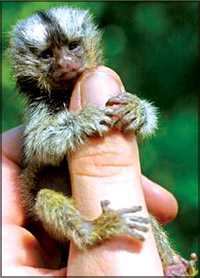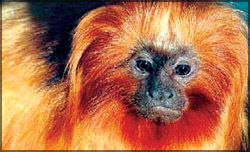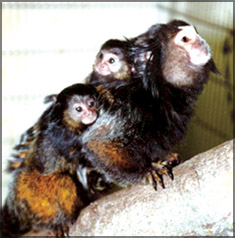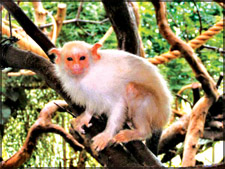|
Marmosets and tamarins:
Real life gremlins!
 Would
you believe that a species of monkeys that fit into your palm exists in
the world? Perhaps not, but there is such a species. Would
you believe that a species of monkeys that fit into your palm exists in
the world? Perhaps not, but there is such a species.
In fact, the famous film producer, Stephen Speilberg's movie
'Gremlins' released in 1984, and World War II Pilot, Ronald Dahl's book
'The Gremlins' published in 1943 were both inspired by these tiny
creatures, the marmosets and tamarins. Even the
|

A baby marmoset |
bard Shakespeare has referred to the marmoset in his literary
work, the 'Tempest'.
These monkeys are an elusive species (difficult to catch hold of),
hardly or never seen as they live only in South and Central America and
that too, in the deep of the Amazon forest.
In all probability, this elusiveness was a contributory factor for
them being nicknamed gremlins after the mythical creature by that name.
However, the Satare Mare Indians in the region claim they have earned
this name mostly because of their appearance and also mischievous
behaviour.
They believe that these magical creatures are reincarnations of their
children. They are familiar with these tiny creatures and it is to them
that a wildlife film maker and biologist turned to when hunting for this
species in the Amazon rainforest to make a movie.
During their search for the elusive golden white tassel ear marmoset,
a hitherto unknown species that they had
|

Golden lion tamarin |
spotted had later been named Satare Maues Marmoset, in honour of the
Satare Mare Indians by scientists.
Both marmosets and tamarins are fascinating animals and are called
New World Monkeys. They belong to the genus Callithrix with about 18
species. Many of these species are either threatened or endangered due
to deforestation. They are also being caught for biomedical research,
and to be sold as pets or zoo exhibits.
While most of the countries where the monkey species is found has
banned the export of those animals, Bolivia, Panama and French de Guinea
still permits the export of marmosets and tamarins which are in high
demand.
Appearance
Marmosets and tamarins are the most diverse and colourful of the New
World primates. They have fine silky hair
|

Pygmy marmoset |
which is multicoloured or marked. Each species has unique
tufts, manes and moustaches. Their diminutive (small) size, which is
between 18-20 cm in length, has earned them the title of 'the world's
tiniest monkeys.'
They are rather primitive in appearance compared to other monkeys.
These creatures have mostly claws instead of nails; only the big toe has
a nail. Both types have tactile (relating to the sense of touch) hairs
on the wrists and lack wisdom teeth.
Marmosets have long lower incisors that help them to chew holes in
tree trunks and branches to get at the sap. Their brain layout too is
considered to be primitive in comparison to other primates.
Their tails which are twice the length of their bodies are not
prehensile (capable of grasping). They use their hind legs to hold on to
the branches and trunks of trees and their claws act as safe anchors.
Like all monkeys, the marmosets and tamarins too have very humanlike
eyes.
Social behaviour
|

A male marmoset taking his babes on a ride. |
Very agile (active) creatures, they are always crossing from tree to
tree, running along branches at high speeds. As they are extremely
active, they travel about 1.2 miles in a day.
They are social animals and live in families of about 15-20
individuals, including one or two females, unrelated males and young.
Usually, the dominant female gives birth to twins or occasionally
triplets. The newborns weigh only one or two ounces the most.
The males are very much involved in the upbringing of babies and even
in the birth process. The father bites off the umbilical cord which
joins mum and babe together, at birth. Whenever mum is not nursing the
little ones, guess who looks after them? Daddy dear of course, so that
the tired mum could take a break.
A very caring and considerate gesture, don't you think? When
travelling about, not only the adult males, but
|

Silvery marmoset |
also females other than the mother, and older offspring all
lend a hand to carry the infants. Yet another display of caring and
sharing, we humans certainly could take a leaf off their book!
Infants who become independent after 12 weeks are taught hunting and
other skills by relatives.
Marmosets and tamarins are generally peaceful animals, but they do
display some aggressiveness when it comes to territorial rights. They
resort to calling, chasing, displaying and gesturing when other animals
try to invade their territory which they scent mark. They also use their
scent glands to communicate.
Both types of animals maintain close family relations by grooming
each other. Grooming is believed to strengthen family bonds.
Eating and living habits
|

Geoffroy’s marmosets |
Even though mostly frugivorous (fruit eaters), they also eat insects,
bird eggs and other small vertebrae, depending on the species. They get
most of the minerals and nutrients they need to survive from fruits and
sap of trees. Unlike the marmosets, the tamarins don't have sharp teeth
and claws to chew holes in tree trunks.
So, they often obtain the sap they need when certain trees such as
the parkia trees ripen and burst, letting out sap, they relish this sap.
Marmosets and tamarins live among the thick foliage in the vertical
forest by day, and sleep on hollow tree trunks at night.
They are mostly found living halfway between the ground and tree
tops, they hardly come to the ground except when searching for insects.
At the first sign
|

Cotton-top tamarin |
of danger, they scuttle back to their hideouts among the
foliage.
Some species of marmosets and tamarins
Bare-eared marmoset
Black tailed and black-pencilled marmosets
Buffy-tufted and Buffy-headed marmosets
Common marmoset
Pygmy marmoset (not endangered)
Silvery marmoset
White-fronted marmoset
Tassel-ear marmoset
Black-mantle tamarin
Emperor tamarin
Red-handed tamarin
Cotton-top tamarin
Mottle-faced tamarin
Bone-faced tamarin
Fact file
* Their body temperature is usually variable.It changes by up to 4
degrees celsius in a day.
* Majority of the species spends 25 per cent to 30 per cent of their
time searching for food.
* Females have two litters per year and have fraternal(non-identical)
twins most of the time.
* The forelimbs are shorter than the hind limbs, but most locomotion
is quadrupedal.
* Hands and feet resemble those of squirrels.
* Marmosets and tamarins are arboreal (tree dwelling) creatures.
* Pygmy marmosets feed primarily on tree sap or gum.
More on the world's tiniest
monkeys next week |
